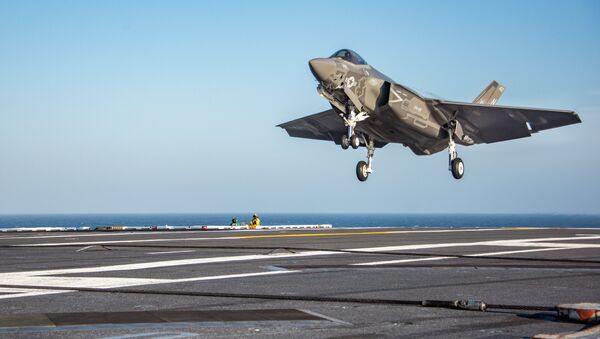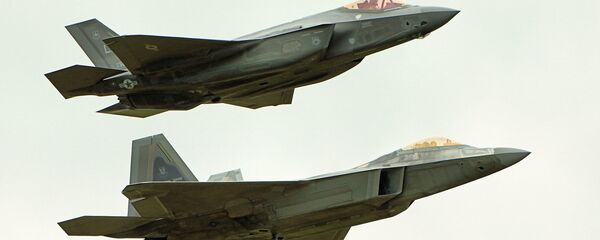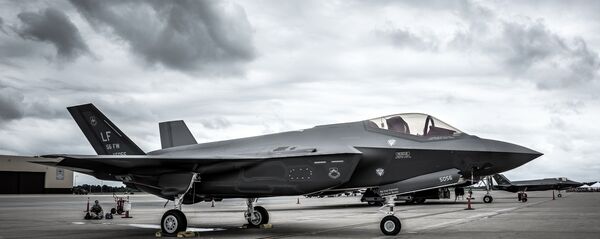In late 2011, the Pentagon’s F-35 Joint Program Office observed the B and C models of the F-35 experiencing “thermal damage” in the rear of the aircraft during supersonic flight, including “bubbling [and] blistering” of the stealth coating on the aircraft’s horizontal tail and tail boom, according to documents exclusively obtained by Defense News.
Both instances occurred while the planes were flying at the edge of their flight envelopes, which according to an Air Force fact sheet, is above 50,000 feet, and when flying at afterburner speeds of between Mach 1.3 and 1.4. The F-35’s maximum speed is between Mach 1.5 and 1.8, or about 1,200 mph, according to Global Security.
Vice Adm. Mat Winter, who leads the F-35 program, told Defense News for a Wednesday article that since testers couldn’t replicate the problem in subsequent tests, no comprehensive fix has been sought, and engineers are getting by with a spray-on coating that provides additional heat protection.
“How often do we expect something like that to occur?” he said. “It's very, very small.”
As a consequence, F-35 pilots are limited to a certain amount of time flying high and fast before their aircraft runs the risk of major damage not just to the stealth coating, but to the antennas on the rear of the aircraft as well.
The documents given to Defense News note that expecting pilots to keep track of how long they’ve flown at a given speed was “not practical/observable in operationally relevant scenarios,” and F-35 pilots criticized the limitations it placed on their ability to perform their missions.
While the F-35’s air superiority cousin, the F-22 Raptor, is capable of supercruise, meaning it can fly above the speed of sound without engaging its afterburners, the F-35 doesn’t have that capability.
“The solution is: ‘Hey, we’ll just limit the afterburner to less than a minute at a time,’” a retired naval aviator told Defense News about the problem. “Which, with what the aircraft is supposed to do and be capable of, that’s a pretty significant limitation.”
“If you want to use it on the first or second day [of a conflict], it has to be stealthy, so you can’t hang a lot of external stores, which means you have to use internal fuel and internal weapons,” the aviator noted. “And that means you have to launch fairly close in, and you’ve got to be close enough to do something to somebody. And that usually means you are in a contested environment.”
“So you’re saying that I can’t operate in a contested environment unless you can guarantee that I’m going to be however far away from the thing I’m trying to kill,” the aviator added. “If I had to maneuver to defeat a missile, maneuver to fight another aircraft, the plane could have issues moving. And if I turn around aggressively and get away from these guys and use the afterburner, it starts to melt or have issues.”
Another naval aviator who is still on active duty pointed out to the publication, "It looks scary on its own, but [the F-18 Super Hornet] has afterburner limits. They’re not that restrictive, but they have them. The aircraft has an afterburner, you want it to work.” They noted that with such a low likelihood of occurrence, though, “I’ll probably have 15 other things fail before that.”
The F-35 is, by now, infamous for its perilous design flaws. Between LEDs in pilot helmet displays malfunctioning, tires that wear out too quickly, refueling probes breaking off in mid-flight, the plane's life support system not providing adequate oxygen to pilots during flights and being unable to fly in certain kinds of weather, the stealth aircraft can’t seem to meet the expectations of its buyers - or the promises of its designers.
In one particular design failing, the F-35 was found to be unable to carry missiles specifically designed for it in its internal weapons bay, requiring it to tote them on wing mounts, which seriously hampers its ability to be stealthy, Sputnik reported.
Another aircraft notorious for heat dangers at high speeds was the Soviet Union’s MiG-25 interceptor, NATO reporting name “Foxbat.” While designed to safely and efficiently operate at Mach 2.35, the MiG-25 was capable of blasting its way up to Mach 3.2 and reaching altitudes above 65,000 feet - both of which far exceeded the capabilities of most aircraft at the time.
However, the MiG-25 had a limited amount of time over Mach 2.8 before the surface of the aircraft would overheat, and in one instance over the Israeli-controlled Sinai in 1971, an Egyptian MiG-25 on a reconnaissance mission accelerated to Mach 3.2 to escape Israeli interceptors - and stripped its engines in the process, according to The National Interest. That plane never flew again.




